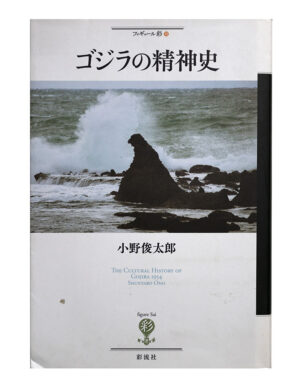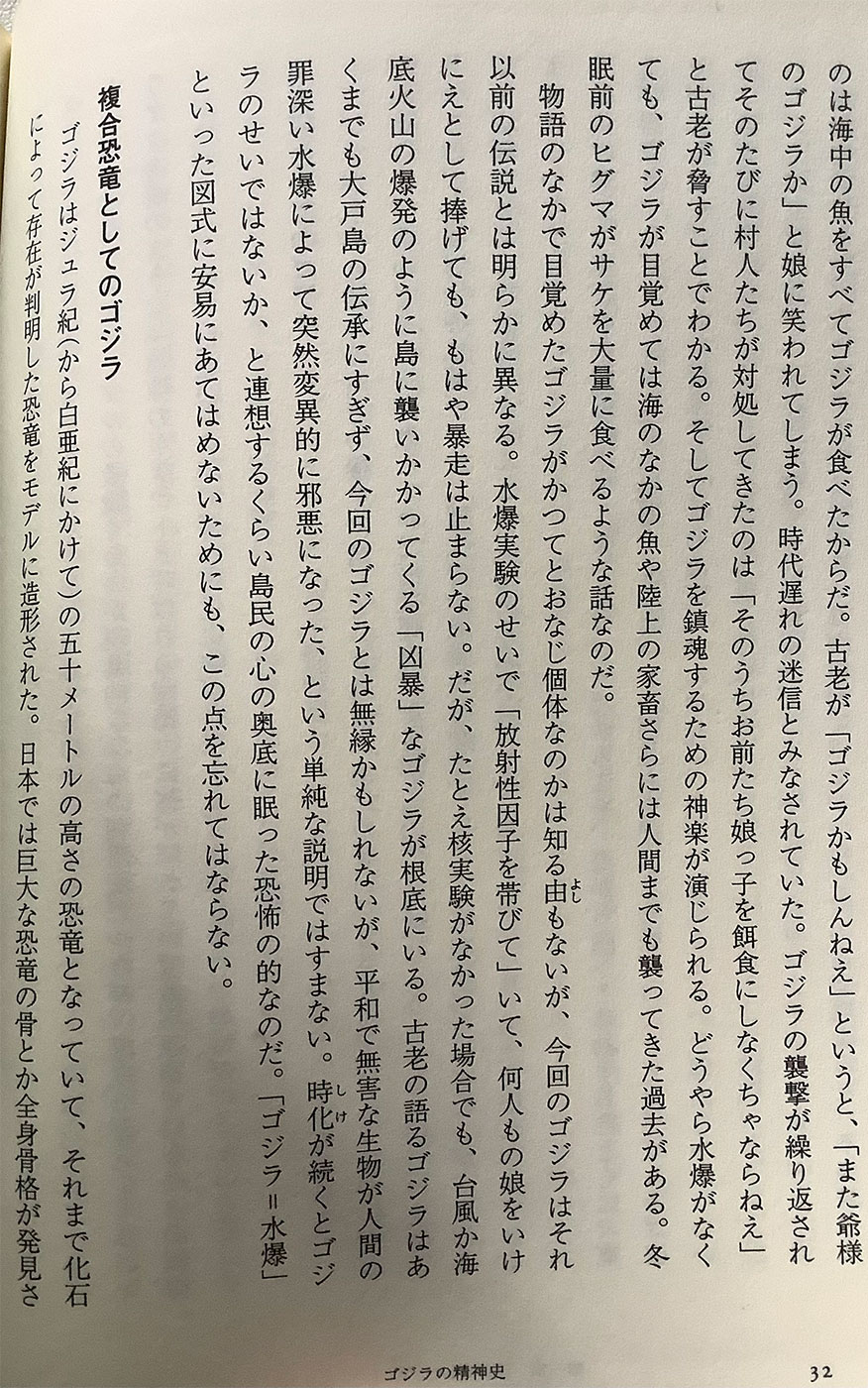10.3.2022
The Cultural History of Godzilla – Pt 13


P 32
ただし、ゴジラはどうやら古生物学者の山根博士が考えているようなロマンチックな生き方をしてきた生物ではない。大戸島に上陸したのもこれが最初ではなかった。村の古老によると、不漁続きなのは海中の魚をすべてゴジラが食べたからだ。古老が「ゴジラかもしんねえ」というと、「また爺様のゴジラか」と娘に笑われてしまう。時代遅れの迷信とみなされていた。ゴジラの襲撃が繰り返され そのたびに村人たちが対処してきたのは「そのうちお前たち娘っ子を餌食にしなくちゃならねえ」古老が脅すことでわかる。そしてゴジラを鎮魂するための神楽が演じられる。どうやら水爆がなくても、ゴジラが目覚めては海のなかの魚や陸上の家畜さらには人間までも襲ってきた過去がある。冬眠前のヒグマがサケを大量に食べるような話なのだ。
However, Godzilla does not seem to have lived a romantic life in the way paleontologist Dr. Yamane thinks. This was not the first time he landed on Odo Island. According to the village elders, Godzilla ate all the fish in the sea for the poor catch. When the old man says, “It might be Godzilla,” his daughter laughs at him, saying, “It’s the old man’s Godzilla again.” It was considered an outdated superstition. Godzilla’s attacks have been repeated, and each time he has been dealt with by the villagers, it is understood by the old man’s threat, “We will have to prey on you girls sooner or later.” Then, Kagura is performed to requiem Godzilla. Apparently, even without a hydrogen bomb, Godzilla has a history of waking up and attacking fish in the sea, livestock on land, and even humans. It’s like a brown bear eating a lot of salmon before hibernation.
物語のなかで目覚めたゴジラがかつてとおなじ個体なのかは知る由もないが、今回のゴジラはそれ 以前の伝説とは明らかに異なる。水爆実験のせいで「放射性因子を帯びていて、何人もの娘をいけ にえとして捧げても、もはや暴走は止まらない。だが、たとえ核実験がなかった場合でも、台風か海 底火山の爆発のように島に襲いかかってくる「凶暴」なゴジラが根底にいる。古老の語るゴジラはあくまでも大戸島の伝承にすぎず、今回のゴジラとは無縁かもしれないが、平和で無害な生物が人間の罪深い水爆によって突然変異的に邪悪になった、という単純な説明ではすまない。時化が続くとゴジラのせいではないか、と連想するくらい島民の心の奥底に眠った恐怖の的なのだ。「ゴジラ=水爆」といった図式に安易にあてはめないためにも、この点を忘れてはならない。
There is no way to know if the Godzilla that awakened in the story is the same individual as before, but this Godzilla is clearly different from the previous legends. Because of the H-bomb test, “it has a radioactive agent, and even if you sacrifice several daughters, the runaway will no longer stop. At the heart of the story is a “violent” Godzilla attacking the island. The Godzilla that the elders talk about is nothing more than the legend of Odo Island, and may have nothing to do with Godzilla this time, but the simple explanation is that a peaceful and harmless creature became mutated and evil by human sinful hydrogen bombs, I’m sorry for the simple explanation. It is a target of fear that sleeps deep in the hearts of the islanders, to the extent that they think that it is Godzilla’s fault if the storm continues. We must not forget this point in order not to easily apply it to the scheme such as “Godzilla = hydrogen bomb.”
複合恐竜としてのゴジラ
Godzilla as a composite dinosaur

P 33
ゴジラはジュラ紀(から白亜紀にかけて)の五十メートルの高さの恐竜となっていて、それまで化石によって存在が判明した恐竜をモデルに造形された。日本では巨大な恐竜の骨とか全身骨格が発見されることはほとんどなかった。歯や骨の一部が出土して、そこから種の同定がおこなわれ、活躍した想像図が描かれるのがせいぜいだった。
Godzilla is a 50-meter-tall dinosaur from the Jurassic period (from the Cretaceous period), and was modeled after a dinosaur whose existence had been identified by fossils. Very few large dinosaur bones or full-body skeletons have been found in Japan. At best, some teeth and bones were unearthed, from which the species was identified, and an image of an active activity was drawn.
五四年当時にゴジラをデザインする際にも、国内にある立体的な標本骨格によったのではなくて、書物などの図版を参照したのだ。最初に依頼を受けた絵物語作者である阿部和助が描いたゴジラは、頭がキノコ雲の形をしてマッシュルームカットのように水爆を直接描き出していた。そのあからさまな表現が却下されると、美術監督の渡辺明たちが、『玉川児童百科事典』に載っていた「イグアノドンの体形を参考に、ティラノサウルスやステゴサウルスを加えた」とされる(『検証ゴジラ誕生』)。
When designing Godzilla back in 1954, he did not rely on three-dimensional specimen skeletons found in Japan, but instead referred to illustrations in books and other sources. Wasuke Abe, the picture story author who received the first request, drew Godzilla whose head was in the shape of a mushroom cloud and directly depicted the hydrogen bomb like a mushroom cut. When that blatant expression was rejected, art director Akira Watanabe and others are said to have added Tyrannosaurus and Stegosaurus, referring to the body shape of Iguanodon, which was listed in the Tamagawa Children’s Encyclopedia (“Verification of Godzilla Birth”).
また、プロデューサーの田中友幸がもっていた『ライフ』誌の恐竜特集のティラノサウルスも参考にしたという。この『ライフ』誌とは一九五三年九月七日号だろう。表紙をブロントサウルスとステゴサウルスが飾り、本文の記事にはカラーのイラストを多用した「生命の饗宴、私たちの棲む世界「第五部」という特集が載っている。 進化の二十億年をたどるとし、いきなり三葉虫の化石の写真から始まる。山根博士が大戸島で発見するあの三葉虫である。そして、海中から生命が陸上へと進化を遂げてきたようすを図解と文章によってたどることができる。
He also referred to the Tyrannosaurus dinosaur featured in Life magazine, which was owned by producer Tomoyuki Tanaka. This “Life” magazine would be the September 7, 1953 issue. The cover is decorated with brontosaurus and stegosaurus, and the main article contains a special feature called “Feast of life, the world we live in” Part 5,” which uses many color illustrations. Let’s trace two billion years of evolution, and suddenly start with a photograph of a trilobite fossil. It is the trilobite that Dr. Yamane discovered on Odo Island. Through illustrations and text, you can trace the evolution of life from the sea to land.